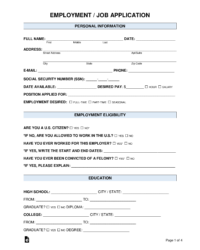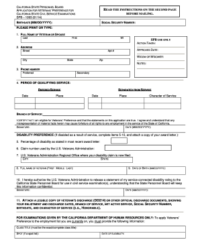This streamlined format offers several advantages. For applicants, it reduces the time and effort required to complete lengthy applications. It also encourages them to focus on the most relevant skills and experiences. For employers, it simplifies the screening process, allowing for more efficient candidate evaluation and faster hiring decisions. A more accessible format can also broaden the applicant pool, potentially reaching candidates who might be deterred by more complex procedures.
The following sections will delve deeper into creating and utilizing this efficient application format, covering best practices for both applicants and employers.
Key Components of a Concise Job Application Format
Effective single-page applications prioritize essential information while maintaining a professional presentation. The following components are crucial for achieving this balance.
1. Contact Information: Accurate and up-to-date contact details are essential. This section typically includes full name, phone number, email address, and optionally, a professional LinkedIn profile URL.
2. Summary/Objective Statement: A brief, compelling overview of career goals and key qualifications immediately engages the reader and highlights relevant skills. This section should be tailored to the specific job.
3. Professional Experience: Work history should be presented concisely, focusing on achievements and quantifiable results in reverse chronological order. Emphasis should be placed on experiences directly relevant to the target position.
4. Education: Relevant degrees, certifications, and training programs should be listed, including institution names, dates of completion, and (optionally) GPA if relevant and above average.
5. Skills: A dedicated skills section allows applicants to showcase core competencies relevant to the position. This can include technical proficiencies, software expertise, language skills, and other relevant abilities.
6. Awards and Recognition (Optional): If space permits and relevant to the position, notable achievements and accolades can further strengthen the application.
7. References (Optional): While often requested later in the hiring process, including “References available upon request” can signal preparedness.
Careful consideration of these components ensures a comprehensive yet concise presentation of qualifications, maximizing the impact of a single-page application.
How to Create a Concise Job Application Format
Creating an effective single-page job application requires careful planning and prioritization of information. The following steps outline the process of developing a professional and impactful document.
1: Determine Essential Information: Analyze the target job description to identify required qualifications and desired skills. Focus the application content on highlighting these specific requirements.
2: Select a Template or Format: Choose a clean, professional template or format that maximizes space utilization. Consider using tables or columns to present information clearly and concisely.
3: Craft a Compelling Summary/Objective: Write a concise and engaging overview of career goals and key qualifications, tailored to the specific job requirements. This section serves as a hook for the reader.
4: Prioritize and Condense Work Experience: Focus on the most relevant work experience, emphasizing quantifiable achievements and results. Use action verbs to describe responsibilities and accomplishments.
5: Highlight Relevant Education and Skills: List degrees, certifications, and key skills directly applicable to the target position. Prioritize skills mentioned in the job description.
6: Optimize Formatting and Layout: Use clear headings, bullet points, and concise language to enhance readability. Ensure consistent font usage and appropriate margins.
7: Proofread and Edit Thoroughly: Carefully review the application for any errors in grammar, spelling, or punctuation. A polished and error-free document demonstrates professionalism.
8: Save in an Accessible Format: Save the application in a widely compatible format, such as PDF, to ensure proper formatting is preserved across different devices and platforms.
By following these steps, applicants can create a concise and impactful document that effectively showcases their qualifications and increases their chances of securing an interview.
Concise job applications offer a streamlined approach to presenting qualifications, benefiting both applicants and employers. By focusing on essential information and utilizing effective formatting techniques, these documents facilitate efficient candidate evaluation and accelerate the hiring process. Careful consideration of key components, such as contact details, a compelling summary, relevant experience, and tailored skills, ensures a comprehensive yet concise overview of an applicant’s suitability for a role.
The adoption of this efficient format reflects a broader trend towards streamlined processes in talent acquisition. Its continued use promises to improve the overall effectiveness and accessibility of job application procedures, leading to better matches between candidates and opportunities.


